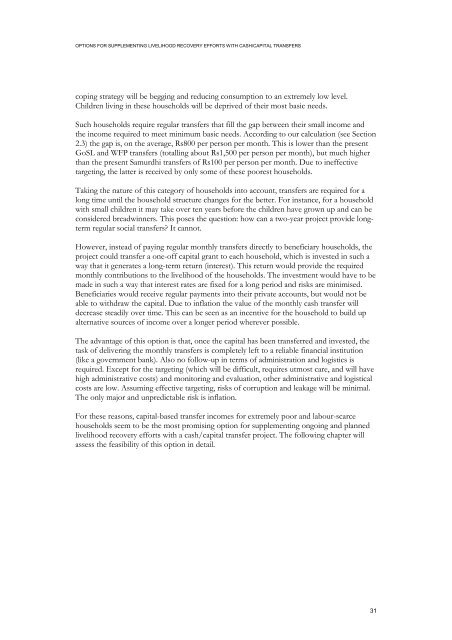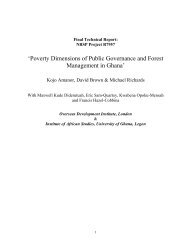Feasibility study on a capital-based income generation scheme for ...
Feasibility study on a capital-based income generation scheme for ...
Feasibility study on a capital-based income generation scheme for ...
Create successful ePaper yourself
Turn your PDF publications into a flip-book with our unique Google optimized e-Paper software.
OPTIONS FOR SUPPLEMENTING LIVELIHOOD RECOVERY EFFORTS WITH CASH/CAPITAL TRANSFERS<br />
coping strategy will be begging and reducing c<strong>on</strong>sumpti<strong>on</strong> to an extremely low level.<br />
Children living in these households will be deprived of their most basic needs.<br />
Such households require regular transfers that fill the gap between their small <strong>income</strong> and<br />
the <strong>income</strong> required to meet minimum basic needs. According to our calculati<strong>on</strong> (see Secti<strong>on</strong><br />
2.3) the gap is, <strong>on</strong> the average, Rs800 per pers<strong>on</strong> per m<strong>on</strong>th. This is lower than the present<br />
GoSL and WFP transfers (totalling about Rs1,500 per pers<strong>on</strong> per m<strong>on</strong>th), but much higher<br />
than the present Samurdhi transfers of Rs100 per pers<strong>on</strong> per m<strong>on</strong>th. Due to ineffective<br />
targeting, the latter is received by <strong>on</strong>ly some of these poorest households.<br />
Taking the nature of this category of households into account, transfers are required <strong>for</strong> a<br />
l<strong>on</strong>g time until the household structure changes <strong>for</strong> the better. For instance, <strong>for</strong> a household<br />
with small children it may take over ten years be<strong>for</strong>e the children have grown up and can be<br />
c<strong>on</strong>sidered breadwinners. This poses the questi<strong>on</strong>: how can a two-year project provide l<strong>on</strong>gterm<br />
regular social transfers? It cannot.<br />
However, instead of paying regular m<strong>on</strong>thly transfers directly to beneficiary households, the<br />
project could transfer a <strong>on</strong>e-off <strong>capital</strong> grant to each household, which is invested in such a<br />
way that it generates a l<strong>on</strong>g-term return (interest). This return would provide the required<br />
m<strong>on</strong>thly c<strong>on</strong>tributi<strong>on</strong>s to the livelihood of the households. The investment would have to be<br />
made in such a way that interest rates are fixed <strong>for</strong> a l<strong>on</strong>g period and risks are minimised.<br />
Beneficiaries would receive regular payments into their private accounts, but would not be<br />
able to withdraw the <strong>capital</strong>. Due to inflati<strong>on</strong> the value of the m<strong>on</strong>thly cash transfer will<br />
decrease steadily over time. This can be seen as an incentive <strong>for</strong> the household to build up<br />
alternative sources of <strong>income</strong> over a l<strong>on</strong>ger period wherever possible.<br />
The advantage of this opti<strong>on</strong> is that, <strong>on</strong>ce the <strong>capital</strong> has been transferred and invested, the<br />
task of delivering the m<strong>on</strong>thly transfers is completely left to a reliable financial instituti<strong>on</strong><br />
(like a government bank). Also no follow-up in terms of administrati<strong>on</strong> and logistics is<br />
required. Except <strong>for</strong> the targeting (which will be difficult, requires utmost care, and will have<br />
high administrative costs) and m<strong>on</strong>itoring and evaluati<strong>on</strong>, other administrative and logistical<br />
costs are low. Assuming effective targeting, risks of corrupti<strong>on</strong> and leakage will be minimal.<br />
The <strong>on</strong>ly major and unpredictable risk is inflati<strong>on</strong>.<br />
For these reas<strong>on</strong>s, <strong>capital</strong>-<strong>based</strong> transfer <strong>income</strong>s <strong>for</strong> extremely poor and labour-scarce<br />
households seem to be the most promising opti<strong>on</strong> <strong>for</strong> supplementing <strong>on</strong>going and planned<br />
livelihood recovery ef<strong>for</strong>ts with a cash/<strong>capital</strong> transfer project. The following chapter will<br />
assess the feasibility of this opti<strong>on</strong> in detail.<br />
31
















